Gateway NV52 (AMD) - OS Benchmarks
The final aspect of operating system performance we want to look at involves common OS tasks. We measure how long it takes to perform the routine operations of booting, shutting down, hibernating, resuming, suspending, and waking your computer using the four test operating systems. Unlike other test results, there was a huge degree of variability in some of the tests. We ran each test at least five times, and we took the best result - the reason being that some of the results were completely out of line with the average result, so including one or two results where the system took four times as long it didn't seem logical. Ubuntu and Windows 7 didn't show as much variation as XP and Vista, particularly in the sleep/wake testing, but the hibernate/resume test once again varies quite a bit between test runs.
The variability remained even after following a relatively straightforward test procedure. First we booted each laptop using the test OS (timing how long it took). Then we let the system stabilize for at least 15 minutes, with no extra applications running and the system sitting idle at the desktop. Finally, we performed one of the other tests - shut down, hibernate/resume, or sleep/wake. Obviously, you can't test resume time without first hibernating, and you can't test wake time without first putting the system to sleep, but otherwise we made sure to shut down the system between test runs.
We also need to mention that Windows XP has an inherent advantage in the hibernate/resume testing because we are using a 32-bit OS instead of a 64-bit OS. That means the system doesn't make use of all 4GB of memory, and the hibernation file is 3GB. Writing 3GB of data will obviously be easier than writing 4GB of data, especially when you're dealing with a 5400 RPM laptop hard drive.
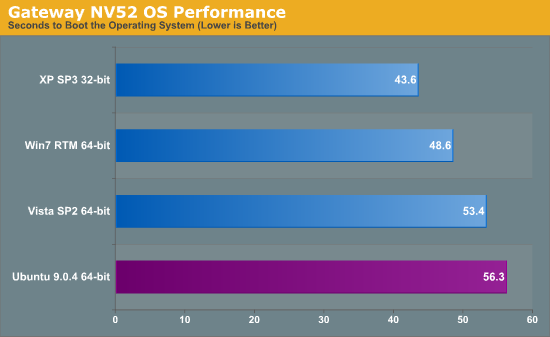
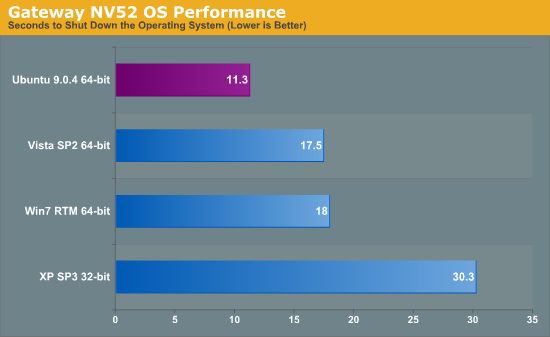
The results are rather scattered this time, with certain functions favoring one OS and others looking better on a different OS. Boot times favor Windows XP, followed by Windows 7 which takes 11% longer. Vista trails Windows 7 by 10%, and Ubuntu brings up the rear at 5% longer than Vista. Shutdown times are a different matter, where Ubuntu takes the lead. Vista and Windows 7 are essentially tied, taking 55-60% longer to shut down than Ubuntu. Windows XP brings up the rear this time, at over 2.5 times as long as Ubuntu, although we have to say that this appears to be a driver issue as the result for the NV58 is radically different. When you shut down Windows XP on the NV52, there's a delay of about 15 seconds where there is no apparent activity, after which the hard drive activity light begins blinking. It would seem that without that handicap, Windows XP would be roughly the same as Vista and Windows 7.
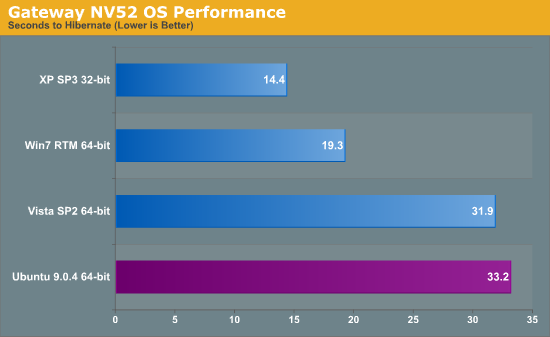
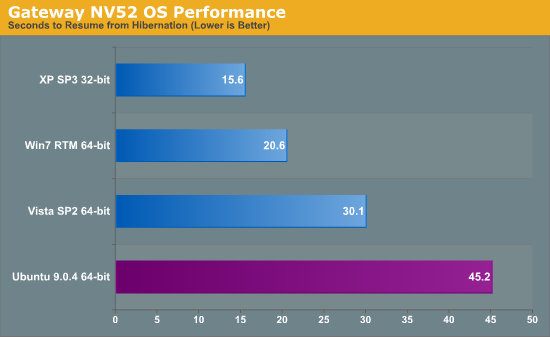
As already stated, Windows XP 32-bit has an advantage for the hibernate/resume testing because it doesn't have as much addressable RAM. It ends up walking away with the hibernate/resume performance crown, followed by Windows 7. That said, the time to hibernate in Windows 7 is 34% longer than Windows XP and resume time is 32% longer; Win7 has 33% more memory, so a 32-bit version of Windows 7 ought to be as fast as Windows XP (or a 64-bit XP as slow as Win7). The gap between Windows 7 and Windows Vista is extremely large for hibernation time, with Vista taking 65% longer to hibernate and 46% longer to resume. Ubuntu is almost tied with Vista on the hibernation time, but it takes 50% longer to resume - about twice as long as Win7 - making it by far the slowest OS for this particular test.
We need to take a moment to discuss boot times and resume times, however, as there's more going on than meets the eye. When booting or resuming a system, the computer needs to perform a Power On Self Test (POST). That takes around nine seconds on these Gateway systems, and once that's complete the boot loader is activated which then loads the OS. Ubuntu uses GRUB and that appears to add an extra ~10 seconds relative to Windows. Without that time penalty, Ubuntu would be far more competitive in boot time (about equal to Win7), although it would still be in last place in the resume test. There are also laptops that have a fast boot feature so that they don't perform a lengthy POST, which can shave another 6 or 7 seconds off the boot/resume times. This is definitely a feature we would like to see implemented on more systems going forward, particularly laptops where users routinely boot or resume several times per day.

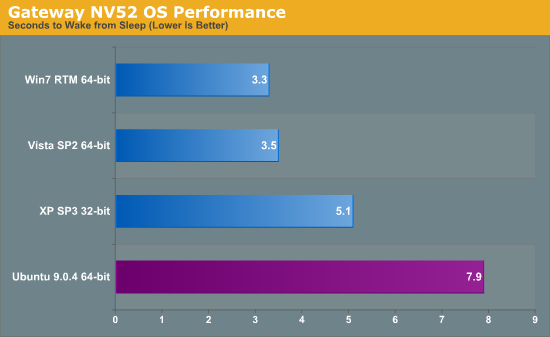
Wrapping up the OS performance analysis, the sleep/wake times were highly variable on the Windows XP and Vista operating systems. This is especially true if you put the system to sleep right after waking it up, booting, resuming, or any other complex task; in those cases, it might take over a minute to go back to sleep. Ouch! It may also take over 20 seconds for Windows to go to sleep if you have a bunch of applications open - that's about six times as long to put your laptop to sleep, which can be very annoying if you just want to pack up and go. You might think that you can just put your system to sleep and throw it in its bag and walk off, but sometimes a glitch will prevent a laptop from going to sleep so we like to make sure our laptops actually shut off before putting them in an enclosed space. We have heard of a few instances where a laptop has apparently overheated because it didn't go to sleep and a user put it in a laptop bag, resulting in a dead system. That's some food for thought anyway. Ubuntu and Windows 7 did a lot better, with the worst-case result being around twice as long as the best time.
Sleep times are a tie between Ubuntu, XP, and 7 at just under 5 seconds. Vista took noticeably longer even in our best-case result, trailing XP by 59%. Wake times mix things up quite a bit and show a lot less variation between runs, with Ubuntu falling to dead last and Vista and 7 essentially tied at ~3.5 seconds. XP takes 46% longer than Vista to wake and Ubuntu is 55% longer than XP (over twice as long as Win7). Again, though, variability in sleep times makes us prefer Windows 7 and Ubuntu followed by XP, with Vista being the worst at consistently going to sleep without a large delay.










106 Comments
View All Comments
nortexoid - Wednesday, September 23, 2009 - link
I'd like to see a test done using "regular" office apps (openoffice, acrobat reader, etc.) and NO internet browsing. (Yes, that's how I use my computer off the plug usually.) It would weed out the performance usage hit taken by Ubuntu when flash is running.It might also be interesting to do a test with tweaked systems, e.g. by tuning Jaunty with PowerTop or similar apps. How does each OS perform when FULLY optimized for battery life (without sacrificing features or much performance, of course)?
7Enigma - Wednesday, September 23, 2009 - link
I know there are users (Jarred apparently you are one of them) that run a system without antivirus/spyware, but you are (or at least should be) in the minority. Linux distro's apparently can get away without it, but on ANY Windows box it's a MUST HAVE. Also disabling those other services (while good at reducing variables) again undermines the system's protection and comparisons to a general usage scenario.In your article I do not think you mentioned what you tweaked (but I could have overlooked this). From my initial impression when reading the article you took both OS' as they were default installed and then tested from there. I think you skewed the results badly in the favor of the Windows platforms by doing this, and I say this as a Windows-only user (never used Linux in any flavor). The first thing I do after a fresh install (still on Vista) is turn off all of those programs you did, along with a host of other services/eye candy using BlackViper's Vista Tweaks. This significantly speeds up the OS in all aspects but can hardly be considered most users configs.
At first reading these comments I was firmly on the "sour grapes" to all of the Linux users complaining about what distro was used, or why X wasn't tweaked by going to a website and reading a tech article, but now I kind of agree with them. Your experience with Windows and lack of experience with Ubuntu had you setting up one for failure before the first test was even run.
Either you test both OS' as they are default installed (driver incompatibilities aside), or you need to have a Linux semi-guru set up your Ubuntu box. My recommendation is the former, as the latter has so many variables it's probably not worth testing in the first place.
Aside from the Ubuntu portion I enjoyed the article. It was very interesting to see how the different power profiles jockeyed for position. I would like to second an earlier commment that asked for idle time to shutdown numbers. Let's be honest, most of us are not going to surf continuously from 100% to dead battery. Rather we are more likely to use the laptop for a bit and then walk away, and come back later. It also will give a good indication of those background tasks impact on battery life (if you don't disable them in your config). I have a sneaky suspicion XP might look very good as it seems to be quite a bit more bare-bones than Vista/7.
Thanks again.
code65536 - Tuesday, September 22, 2009 - link
An Intel engineer explained it some years ago in a blog posting: XP's max battery basically throttles the CPU's frequency down all the time. For example, on my Core2Duo, it'd mean that the CPU will operate at 800MHz all the time, even when it's busy. On the other hand, if Windows gives Speed Step a free hand and lets Speed Step determine the speed, then the CPU will operate at 2GHz when busy, and slow to 800MHz only when it's idling. According to this Intel engineer, it makes no sense to have it always throttled to 800MHz, because that means that tasks will take longer to finish, and the CPU will spend less time idling (which is when the CPU *really* saves power), and he labeled the max battery mode as the "what the hell are you doing?" mode.Drizzt321 - Tuesday, September 22, 2009 - link
I completely understand your complaints on the length of time required to run the test, plus recharge the battery. Have you considered buying a 2nd or 3rd battery and finding an external charger? Or would that kill the results of the test because the battery would be different?PepperPot2 - Tuesday, September 22, 2009 - link
I fail to believe you included the default grub time in the boot as this to do so would be unrepresentative of real use. Who would sit there and wait for it to time out rather than just press the enter key triggering the boot process? Anyway a default install of ubuntu (where it is the only OS on the machine) doesn't show the grub menu, only a 2 second alert to allow you to bring it up if you want. I then immediately boots.My experience with ubuntu is totally contrary to the conclusions you just posted about speed. We've have ~20 installs of Ubuntu 9.04 at work on old machines (7 yrs old) to a machine I built 1 month ago. In all instances the staff find it it is smoother and quicker to use than the dual boot copy of vista or XP.
The boot time on XP is clear nonsense, when ubuntu boots to the desktop you can use it almost immediately. XP is typically totally unusable for ~30 seconds while it loads more crap in the background. Vista is worse.
jasperjones - Tuesday, September 22, 2009 - link
That's true, XP and Vista are pretty unresponsive for a minute or so after boot on your average entry-level laptop. OTOH, Ubuntu is snappy once you see the GNOME desktop. 9.04 is called jaunty ducy ;)However, the same can be said of Win 7. It keeps loading stuff after you see the desktop, but that doesn't make the system feel sluggish--not at all
JarredWalton - Tuesday, September 22, 2009 - link
The Windows boot times are stopped when I see the default system try icons appear (WiFi connectivity, volume, etc.) so the system is pretty much usable at that point. As for GRUB, it's a 2 second timeout, which I could bypass by pressing enter twice, but that still leaves around 8 seconds from the POST to the point where it looks like Ubuntu is actually loading. What's going on during that time? If we subtract POST times, then Ubuntu would look even worse. I can see about tweaking GRUB to skip straight to loading the OS and see if that helps as well... when I get time.jasperjones - Tuesday, September 22, 2009 - link
FYI--one can simply configure GRUB to not wait for user input by editing /boot/grub/menu.lst and changing the second or third line from "timeout x" to "timeout 0"But I generally completely understand the argument not to change too many things from the default installation of Ubuntu, as it's doubtful that the average user would do it.
maveric7911 - Tuesday, September 22, 2009 - link
I would love to see a properly installed and setup distribution of linux in this review (not bashing love that you included linux at all). As others stated above Archlinux would be a pretty good choice. All packages come optimized and things like native 64bit flash and other native 64 bit applications are apart of the stable repository "no adding repos necessary". Also as mentioned, not using the hardware accelerated driver of ati or nvidia will take a big hit on power right away. I'm always available to assist with any linux testing and/or questions.HP
Sr Linux Engineer
andrewaggb - Tuesday, September 22, 2009 - link
What I would like to see is Jared run all the tests on his version of Ubuntu, then let a linux expert have some ssh love to tweak it all up, and then let Jared run the tests again and see how much difference he finds.